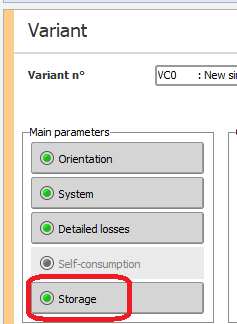Grid systems with storage
You can activate the storage options in the storage window.
Context
An increasing number of grid-connected PV systems are now being combined with battery storage. The objectives of such hybrid systems vary depending on the application, for example:
- Maximizing self-consumption: minimizing reliance on grid electricity regardless of tariffs.
- Economic optimization: managing charging and discharging according to consumption patterns and electricity tariffs (consumption and feed-in).
- Grid support services:
- Shifting PV injection to specific times of the day, peak shaving, or
- Providing short-term grid stabilization (e.g., under variable cloud conditions).
- Backup power: ensuring supply continuity in case of grid outages.
- Energy access: maintaining availability in areas with weak or intermittent grids.
- Mini-grids / off-grid electrification: supplying entire villages, islands, or remote sites.
Each of these applications implies different system designs, constraints, energy flows, and control strategies. Control strategies depend both on the load profile and on the characteristics of the grid (availability, stability, possible overload).
A key element is the battery charge/discharge strategy, which determines when the PV array or the grid should charge the battery, and when the stored energy should be released. This may be based on:
- State of charge (e.g., charge whenever the battery is not full).
- Load demand (e.g., discharge during periods of high consumption).
- Time-of-use or dynamic tariffs.
- Forecasted PV production or weather conditions.
- Prioritization of how much of the available PV power is directed to the battery versus to the grid or direct consumption.
Implementation in PVsyst
PVsyst provides 4 main strategies for integrating battery storage with grid-connected PV systems:
- Self-consumption: direct consumption of PV production, with surplus stored for later use.
- Power shifting: delay grid injection to benefit from time-of-use rates.
- Peak shaving: store energy when production exceeds grid injection limits.
- Weak grid recovery: maintaining supply when the grid is unstable or unavailable.
Each strategy comes with specific requirements and constraints:
- Self-consumption and Weak grid recovery require the definition of a user's needs (load) hourly profile.
- Weak grid support additionally requires a grid availability/unavailability profile.
- Depending on the configuration, Weak grid support may or may not allow reinjection of PV surplus into the grid.
- With the Self-consumption and Weak grid options, the battery energy is never used for feeding the grid.
- For self-consumption and Weak grid, battery charging only starts whenever PV production exceeds the instantaneous load demand.
- Peak shaving and Power shifting are primarily grid-oriented strategies; they do not rely on a user load profile.
- The battery discharge schedule may differ according to the strategies, cost optimizations, etc.
The sizing of the PV array and the battery (relative to the load profile, storage needs, and electricity prices) is a complex task and highly dependent on the chosen strategy. In PVsyst, only simplified sizing guidelines are provided.
System Implementation
Grid-connected storage systems require specific power electronics, including hybrid inverters, battery chargers, and energy management controllers. Manufacturers usually provide integrated solutions, making exact modeling of device-specific behavior complex.
In the grid storage implementation of PVsyst, charging and discharging are approximated using generic converters (see batteries):
- Charging (AC → DC) and
- Discharging (DC → AC)
These converters are characterized by an efficiency curve as a function of power and a maximum nominal output power (PNom). The associated conversion losses are reported in the system loss diagram.
Cost of Stored Energy
Adding storage to a PV system introduces a specific cost of stored energy, expressed in price per kWh.
This cost corresponds to the maximum energy stored in the battery pack during its lifetime, divided by the cost of the battery pack replacement.
The simulation accounts for battery ageing as a function of operating conditions (number of cycles, depth of discharge, and temperature). It models capacity degradation over time and triggers battery replacement when end-of-life is reached. This strongly influences both the financial assessment and long-term system performance.
Updates
- Power shifting was added in PVsyst version 8.0.17.
